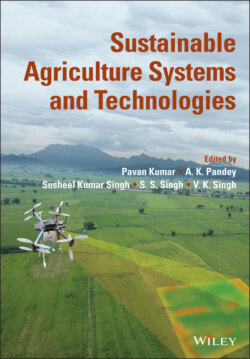Читать книгу Sustainable Agriculture Systems and Technologies - Группа авторов - Страница 18
1.2 Growth of Agriculture in India
ОглавлениеIndia is a leading producer of food grains, milk, wool, and other agricultural products. But what is the situation at present and how has India become what it is today, the journey to achieve this position was not a child's play. It began in the 1960s with the advent of the green revolution. During the independence period, India was left with own national governance and food insecurity. We were importing rice and wheat to feed the starving population. In 1966, India was the leading importer of rice and wheat. This was the time of introduction of green revolution. Introduction of dwarf wheat variety, subsidies on fertilizers, irrigation expansion, procurement at minimum support price, and chemicals for crop protection were done to increase the production (Mandal et al. 2020; Pandey et al. 2015). And the improved package of practice actually increased the production manifold. In 11 years, India’s wheat production increased 205% and rice production increased 72% (Table 1.1) bringing India among the leading exporters at the global level in 1977–1978. The productivity (kg/hectare) increased 79% in wheat between 1966–1967 and 1977–1978, which was a record increment. The increase in rice productivity (kg/hectare) was 51% between 1966 and 1977. Since then, the production of wheat has but rice has not seen a setback. Area under wheat grew at an annual rate of 1.68 while production speeded up with Compound Annual Growth Rate (CAGR) of 4.3. Wheat has been a winner in green revolution with record increase in production and ensuring that the country is food secure. Area under rice grew at an annual rate of 0.55 while production speeded up with CAGR of 2.45.
Table 1.1 Percentage change in area production and productivity of wheat and rice in India.
Source: Indiastat.com,www.fao.org/faostat.
| Year | Area | Production | Productivity | |||
|---|---|---|---|---|---|---|
| Wheat | Rice | Wheat | Rice | Wheat | Rice | |
| 1965–1966 | 17.7 | 13.4 | 29.6 | 8.4 | 10.3 | −4.4 |
| 1977–1978 | 70.7 | 13.6 | 205.5 | 72.2 | 79.0 | 51.7 |
| 1989–1990 | 9.5 | 4.7 | 57.0 | 39.7 | 43.3 | 33.4 |
| 2001–2002 | 12.1 | 6.5 | 46.0 | 26.9 | 30.2 | 19.1 |
| 2013–2014 | 15.7 | −1.7 | 31.7 | 14.3 | 13.9 | 16.2 |
Wheat and rice are among the staple food of the country. Apart from this the government of India procures wheat and rice at Minimum support price and distributes it to the below poverty line population at subsidized price under National food security programme (Bisht et al. 2014; Singh et al. 2013; Tomar et al. 2014; Yadav et al. 2014). It is known that wheat and rice have a lion's share in procurement under Minimum Support Price. This has led to cereal dominance in food grain production. Per capita availability of food grains has shown increase in rice, wheat, and cereals, while it has declined in the case of gram, pulses, and other cereals (Figure 1.1). This reveals that the advent of green revolution has shifted India from food insecure to food secure country. This raises up a question that whether being food secure ensures zero hunger?
